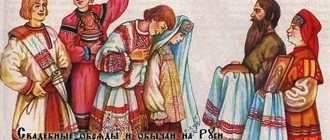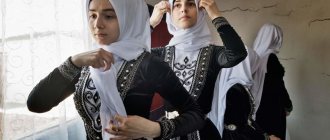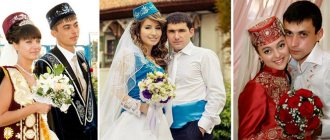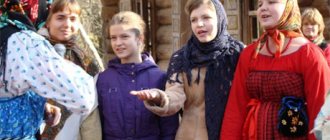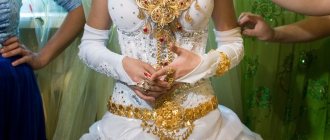In Karachaevsk it has become fashionable to dress the bride in a national costume. Photo by the author
The times when Karachais stole brides are gradually becoming a thing of the past. Now this happens extremely rarely, and only with the girl’s consent. The situation is different now: if earlier parents themselves looked for a wife for their son who would be his equal in status and wealth, now young people, as a rule, marry for love. However, many wedding traditions have been preserved. From time to time, a motorcade with carpeted cars rushes through the streets with sirens. This is a Karachay wedding - with its own customs and national flavor.
Circassian bride price: features and traditions
Like all the peoples of the Caucasus, the Circassians observe the tradition of ransom or kalym. They had almost no misalliances due to the considerable ransom amount. For example, a peasant could not, for certain reasons, pay the bride price, which was demanded by the bride’s family of a higher social rank. Usually, several heads of cattle, money and horses were attributed to the bride price. And also add several bulls and/or a horse as a gift to the girl’s father. The mare was also given to the effendi, who officiated the wedding.
An impressive bride price is one of the few reasons for observing levirate. This is a tradition in which a girl is obliged to marry her husband's brother in the event of his death. There is also still a tradition of sororate, when a widower, in turn, marries the sister of his deceased wife. After receiving the bride price, the family helped their daughter with the dowry, the cost of which was equal to half the bride price. If the bride was wealthy, then the value of the dowry was equal to the bride price and the property was usually movable.
Traditions of the past
Among them:
- Karachay wedding always required observance within the same family. This means that the younger one cannot marry before the older one. A similar rule was extended to the male half;
- there is a ban on marriages within the same surname or relatives who are part of a single group called “kauum” and have a common ancestor. Previously, it even came to expulsion from the village;
- polygamy. In fact, a husband could have two wives in a situation where the first one could not bear children for him, or if she, due to old age or illness, was unable to do housework. The first enjoyed special respect, and the second was only subordinate to her and all the hardest work fell on her shoulders.
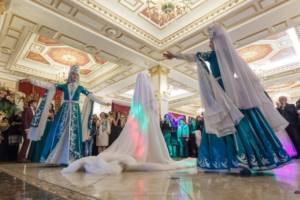
Marriage registration options
The Circassian people allowed three options for marriage, namely:
- traditional matchmaking;
- abduction of a girl with her consent, but against the will of her parents;
- kidnapping a bride against her own will.
It is worth noting that the latter method today is gradually losing relevance against the backdrop of changing living conditions and traditions.
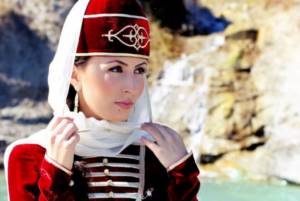
In the 19th century, Karachais also adhered to religious motives in marriage relations. With the adoption of Islam, marriages with representatives of other nationalities were somewhat limited. However, among the Karachais there were many mixed marriages between the Karachais and neighboring peoples. In particular, the princely family willingly became related to the Kabardians, Abkhazians, Abazas, Nogais, Svans, and Ossetians. The genealogical legends of the Karachais, as well as archival data, tell about this.
The marriageable age for a man began at 18-20 years old, and a girl was declared a bride at 14-15 years old. The usual age of marriage was determined to be 22-23 years for a man, and 18 years for a girl. But it happened that girls were married off at the age of 13-14, and men got married at a much older age. Moreover, the family strictly observed the order: the youngest was not married until her older sister got married. This rule (tamadalyk saklau) also applied to men.
Despite the fact that the Karachais professed Islam, polygamy became widespread in Karachaen. In rare families there were two, very rarely - three wives. Facts of bigamy among the peasantry occurred in the case when the peasant did not have children from his first wife, or, if necessary, to have an able-bodied wife in the house, if it happened that the first wife was bedridden due to old age or illness. The first wife always enjoyed the greatest respect and honor. The second one had to obey the first one in everything and did more difficult housework. “Rather than marry as a second wife, it’s better to stay at home” (Katyn yusyune bargandan ese, tybyrda kalg’an igidi), says a Karachai proverb.
Some researchers (V. Teptsov, N. Tulchinsky and others) tended to see in the monogamous mountain people “commitment to the indigenous customs of the people,” others (M. Kovalevsky) - “remnants of Christian traditions.”
The mountaineers had several forms of marriage:
1) marriage through matchmaking, in which the families of those getting married agreed in advance. These included: a) marriages through an agreement to pay the dowry; b) levirate and sororate; c) marriage by bride exchange;
2) secret marriages or marriages by abduction. Here they differed:
a) forcible abduction of “kachyryu”; b) imaginary kidnapping or marriage by “runaway” (jashyrtyn).
Collusion also came in several forms. Engagements were practiced between young children who were in the cradle, and sometimes even unborn children (“auz blabir-birine sez beriu”). Both of these forms were closely connected by the “kalym” marriage.
Among the surviving forms of marriage is the so-called “tul toy” marriage. Levirate or adultery (the marriage of a widow with the brother of her late husband) was manifested in the fact that after the death of her husband, the widow remained in the family of the deceased husband, since the bride price was paid for her, and married her brother-in-law - the unmarried brother of the husband or his relative. There was also this form of levirate marriage: if the groom died before the wedding and the girl remained betrothed in her father’s house, and the bride price had already been paid, then the brother of the deceased groom could marry her. The highlanders were guided by one concept, namely: widow (tul katyn) -“ the property of the family of the deceased, which, therefore, with the rest of the inheritance, should go to the remaining members of the court after his death.”
There were also remnants of the sororate institution (marriage between a widower and the sister of his deceased wife) among the Karachais.
There were frequent cases of marriage of two siblings to half-sisters (eki egech eki karnashda). A special form of marriage was the so-called exchange marriage. In such cases, families exchanged daughters, marrying them to the sons of the other party, or one of them gave his daughter to the son of the other, and he gave his sister to the brother of the first. In the same way, the young men exchanged sisters or girls of more distant degrees of kinship.
One of the ancient forms of marriage in the past was kidnapping (“kyz kachyryu”). The abduction of a girl for the purpose of marriage was caused primarily by fear of the failure of attempts to positively resolve the issue peacefully, or due to the girl’s refusal of her promise to marry, and sometimes if the girl did not have enough money to pay the bride price and was delaying the wedding too much.
Most often, secret abduction was carried out with the consent of the girl by bribing surrounding women and with the assistance of the kidnapper.
A successful abduction led to the young man receiving consent to the marriage of both the bride and her parents. Moreover, the groom sometimes got rid of paying the dowry altogether. But sometimes the girl’s parents did not go to the groom’s house for years, and he, in turn, also avoided meeting them, because if the abduction was carried out without the girl’s consent, then such a marriage, according to Sharia, was considered invalid.
Usually the groom resorted to kidnapping when he was sure that his relatives, being influential people, would support him. The unsuccessful abduction and return of the bride to her relatives was considered a disgrace for the groom and his relatives. On the other hand, the abduction of a girl was considered an insult to her family and a humiliation of the girl’s dignity. Therefore, a wide circle of relatives of both sides was drawn into the conflict that arose on this basis, who made every effort to calm the bride’s relatives.
First of all, the proxies sought to extract the girl’s consent to this marriage, because, according to popular opinion, a girl once “captured” (“suyrelgen” - lit. “carried away”) lost honor for the rest of her life. Therefore, in most cases, a girl who was taken away and hidden, even without being kidnapped, rarely agreed to return home to her parents, because She considered herself “disgraced.”
As a rule, multiple visits and negotiations ended in reconciliation of the parties, and the groom, in addition to the bride price, also paid a penalty for dishonor. Otherwise, hostility arose, leading to dire consequences.
The main form of creating a family was marriages, carried out by free agreement of those entering into it and their parents, based on customary law and the indispensable payment of kalym.
Initially, in Karachay, the bride price was paid not to the family or the father, the girl’s teacher, but to the whole clan group - “kaumu”, to which she belonged, later - to a narrower circle of relatives - “ataul” and, finally, to the girl’s family “kyz yuyune”.
Giving a girl away in marriage without a kalym was considered a disgrace for her family and clan. “Kalym on a large scale is the scourge of the mountain population, because, while ruining one family, it does not enrich the second, which spends everything received in kalym with the addition of its own on gifts and various treats,” notes the head of the Karachay site in his report. He further wrote that “it would not be superfluous to establish the payment of kalym for the poor classes from 40 to 80 rubles, for the middle classes from 80 to 200 rubles and for the rich no more than 500 rubles.”
As for the gifts brought by the groom during matchmaking, in “nekyakh” a horse was spoken in favor of the bride’s father or uncle (“ana karnash”), a horse in favor of her brother (“etechden tuugan”) and a horse in favor of the dairy mother (“syut ana”) ").
Negotiations about bride price and gifts “berne”, their sizes were conducted during the matchmaking. The agreement between the groom's matchmakers and the bride's relatives was concluded in the bride's house. A deposit was usually made right there, and then the marriage ceremony (nekyah) took place, performed by the effendi.
Payment of the main part of the dowry was made over several terms. The dowry could be paid in money, weapons, livestock and other valuables. Instead of money or livestock, sometimes the dowry was paid in plots of arable and mowed land, but also in terms of money.
According to custom, the entire bride price should have become the property of the bride, but in reality it was controlled by her parents.
If it happened that the groom died before the wedding, then the girls’ relatives had the right to demand half of the agreed upon price. They received the same part of the bride price if the groom refused it.
Due to the fact that arranging a wedding required significant expenses, the young man, already at the age of 15, was forced to begin preparing for the wedding. According to V. Ya. Teptsov, he had to “prepare the dowry and all other expenses himself, with his own hands.” If he thought of standing out from the family, then it was necessary to build a new hut and start a new farm. All this, as the same author notes, “required years of patience and labor, especially for the poor.”
The dowry (“yuy kerek”) and gifts presented by the bride to the groom’s house (“berne”) are to some extent connected with the institution of kalym. This connection consisted of their imaginary equivalence. Unlike the “kalym”, the composition of the dowry and bernene were strictly defined. The girl's wedding dress and dowry were compiled from various gifts presented to her by her relatives on various occasions, as well as from the collection of personal property. Among Karachay girls and boys there was a custom of “jashyrtyn hapchyuk dzhiyg’an adet” (lit.: secret collection of property, or “shenchyu”). Girls were allowed to have private property in their personal property, acquired through the sale of “stolen” wool, cloth, etc., and the boys, in turn, secretly from their father and mother sold the livestock of a flock or herd.
The girl's dowry consisted mainly of clothes, cotton linen, silk shirts, beshmets, a silver belt, a bib, scarves, shawls, etc., bedding, carpets, felts, chests, caskets, various sizes of basins, kumgans, cauldrons and other utensils . All this, coming to the use of the young family, at various times was considered the personal property of the bride and “had to be returned to her in the event of a divorce”1. Representatives of the upper class sometimes gave their daughters “eget” serfs and “digiza” maids when they got married.
A special place in the dowry was occupied by “berne”, that is, gifts for the groom’s relatives - items of clothing, various small items - tobacco pouches, cords for trousers, pistols, watches, etc. The expenses on them reached a significant amount and were not less than the preliminary dowry. The bride's parents had to prepare and provide gifts to all members of the groom's family. The father and mother of the groom were offered full national costumes. For the groom’s grandmother, the shilibeshmet “syrylgan kaptal”, which replaced a coat, for the grandfather - a caftan (kaptal), then one or two pieces of clothing were prepared for the brothers, sisters, nephews and nieces of the groom, for girls - small items: earrings, rings, belts, mirrors, thimbles, scarves, boxes, and other things. The girl’s parents especially noted the matchmakers, providing them with cloth, clothes, livestock, weapons, because when performing the marriage ceremony, the matchmakers contributed some money from their personal pockets. Then came gifts brought by the groom to the bride’s house, gifts from the bride to the groom’s relatives, gifts to the groom’s uncle, who delivered the so-called “toi mal,” i.e., the cattle necessary for the wedding, gifts from the father of the bride to the groom, etc.
Despite the fact that marriages in most cases were carried out through a free agreement with the bride’s parents, however, under the conditions of the dominance of patriarchal relations in the family, the choice of a bride for a young man depended on the will of the parents; often the consent of the bride and groom was not required.
Although when choosing a bride, the girl’s personal qualities were also taken into account (beauty, age, good manners, diligence in needlework), but often the bride was judged by her parents. Usually the groom informed one of the meeting participants about his choice in advance, but often the “suitable match” for his son was selected by the mother, father or their closest relative. The son could announce his choice to the mother or the intermediary (“seleshdirgen adamga”). Then friends and comrades began to “strenuously propose the girl intended by the groom, praise her merits” and tried to persuade “the groom’s parents in her favor.” It also happened that neither the father, nor the mother, nor the groom himself could first designate and then he was “given the way” (“jol beriu”), they set a certain deadline for choosing a bride. The young man went around visiting his relatives to swear that so-and-so would marry so-and-so of his own free will, and that the bride would marry so-and-so of her own free will. Having received an affirmative answer from the representatives, the effendi read the marriage prayer from the Koran and thereby completed the ceremony. From that moment on, the marriage of the young was considered legal. For those who did not perform the ritual described above, their children were considered illegitimate (nekyakhsyzla).
If, after performing this ritual, the groom refused the bride, then he paid half of the agreed upon bride price, and if he exercised his marital rights, he paid the bride price in full.
After the ceremonies described above, the parties prepared for the wedding, since the girl was already considered a bride. The girl and her family prepared a dowry, Iberne outfits, and the groom’s side began to pay the bride price in parts. Usually, when performing nekakha, the groom’s side paid a third of the dowry, and corresponding gifts were also made. Depending on the condition, the father or brother of the bride was given a horse and a pair of bulls, and the effendi who made the arrangements for the nekyah was given one horse or 10 rubles.
A few days before the wedding, special persons were appointed to notify and invite guests, prepare food, slaughter rams and bulls, bake ritual pies, brew buza, and beer. Before sending people to pick up the bride, a meal (atlangan ayak) was arranged, where those wishing to participate in the wedding procession were determined. The participants in the wedding procession (kueu jöngerle) made up a group of horsemen with flags (bayrak), which depicted the groom’s family brand over the bride’s family brand, and followed the bride with the song “Orayda.” In some cases, the wedding procession was accompanied by the groom, but mostly without him. The retinue was headed by an honorary man (toastmaster kyueudjonger) - the groom’s closest relative.
They dressed the bride in a national costume (toi chepken). The eldest of her friends reported that the bride was dressed up, but needed a veil over her head. Then the groom’s best man presented a blanket (au dzhauluk) with a wedding ring. Then the ritual of “transferring the bride from the mat” (“kelinni dzhegendentyushuryuu”) was performed. This was entrusted to a close relative of the groom - usually his younger brother. He approached the bride, took her by the hand and said: “Kelinim, dzhanaim, ogur ayak bla atlandyrayim” (Bride, my soul, I will accompany you on a good journey). They took several steps towards the exit, for which the best man presented the women on the bride’s side with a certain amount of money (jegenden tyushürgenlik).
Under parting words and blessings, the bride was seated in the saddle and handed over under the protection of a guide sitting behind her on the same horse, usually a man of respectable years, who, holding the bride with one hand and driving the horse with the other, set off on the road. Back in the second half of the 19th century. the bride was taken away on a cart (tarantass), decorated with felt, and next to her sat a girl who had come from the groom. The wedding train was not allowed out of the yard, the game continued - the battle of youth. After a special fee “kabakbegitgenlik” (kabak - gate, begitgenlik - for closing), the wedding train left the yard.
The bride was accompanied, in addition to the groom's groomsmen, by several people from her family and friends (kyiz jongerle).
The horsemen accompanying the wedding train pranced on horses, sang songs, and fired rifles and pistols. The riders' horses were decorated with multi-colored scarves and towels, which were called flags (bayrak). Ahead of the car were real flags depicting the tamga of the bride and groom. Losing them was considered a great shame. One of the standard-bearers “al atly” separated from the wedding retinue and rode up to the groom’s house at full gallop, singing the wedding song “Orayda.” Soon the rest of the horsemen arrived. Rushing through the crowd standing in the courtyard, riders on hot horses rushed into the room. Some people managed to ride a horse into the premises, for which they received an appropriate reward3. A woman from among the groom’s relatives (eki nasyby bolgan tishiryu) came out to meet the bride, who took her by the arm and walked slowly into the room prepared for her. At this time, the singing of the solemn wedding song “Oraida” intensified.
When the bride crossed the threshold (certainly with her right foot), exclamations were heard: “Happiness is entering the house!”
The entry of the bride into the groom's house (otou) - one of the most important moments of the wedding ceremony - was accompanied by a number of customs. To protect the young woman from evil spirits and witchcraft, a dagger was held over the girl’s head, and a horseshoe was placed at the threshold. When the young woman entered the groom’s house, she was showered with coins, sweets, nuts, and grain, “so that there would be abundance and wealth in everything.” The children collected all this, and the elderly women, mother-in-law and girls present hugged the bride. The venerable old man, holding a bowl of buza (“goppan ayak”) in his hands, pronounced a toast (algysh), which expressed the wish that the bride’s arrival would bring happiness to her new family. The toast contained advice to the young couple, a kind of poetic set of rules for behavior in everyday life and in a team.
In the newlyweds’ room – “otou” – the bride was placed in a corner.
Nuances of the matchmaking stage
Matchmaking and collusion in their scheme resemble Karachay celebrations. Before the wedding, the bride was taken to an intermediate house, that is, a room that did not belong to any of the families. Usually this role was played by the house of a friend or distant relative on the groom’s side, where he visited the girl. But accompanied by a friend who had been with him since the bride was taken out of her parents’ house. The timing varied and was determined by various factors, for example, the girl’s readiness for the wedding and receptions.
The bride was allocated a special, personal room - legyune, and no one except the girls was allowed to be in it. The tradition was preserved not only during the wedding period; the room was generally considered an inviolable part of the house. It was so guarded that it was forbidden not only to make loud noise or talk nearby, but even other people’s animals nearby were scared away.
Only children and younger members of the groom's family had the right to enter the premises. There were cases when the groom's parents could not cross the threshold of the treasured room until their death.
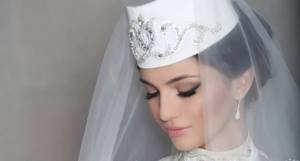
He handed over the bride price - and went to jail
A Karachay wedding is not a cheap affair. Nowadays, expenses for “burne” (mutual gifts from the bride and groom) often reach significant amounts, and many Karachays, in order to look “worthy,” even take out large loans from the bank. The unspoken rule was that gifts included not only expensive scarves and suits, but also gold jewelry, which was given even to the bride’s brothers. Therefore, the authorities regularly try to keep residents from spending heavily on a wedding, which could undermine the budget of poor families. Even at the dawn of Soviet power, in 1924, the chairman of the Karachay district executive committee, Comrade Aliyev, for example, issued a special law in the Karachay-Cherkess region, according to which the payment of bride price for a bride was punishable by imprisonment or forced labor for up to one year.
Representatives of the CPSU also fought against Karachay's magnificent wedding offerings. The elders of Karachay-Cherkessia today also oppose wastefulness on weddings. According to the deputy of the Spiritual Administration of Muslims of Karachay-Cherkessia and Stavropol Ismail Bostanov, the poor segments of the population, in order to have a luxurious wedding ceremony and keep up with the rich, work day and night and go into debt. Despite this, the Karachais continue to cling to these customs, give gifts, weddings are still as magnificent and numerous, and cars with luxurious carpets continue to rush through the streets.
Karachaevsk
Bride kidnapping stage
The theft of a bride from the Circassian people, unlike many others, is still relevant today. The theft scenario is different from the well-known film. Usually the second previously mentioned option occurs, in which the couple has been communicating for a long time and after a period the groom expresses a desire to kidnap the girl for the wedding. At the same time, without hiding his intentions from her. After the stage of kidnapping the bride, a delegation from her side must come and ask for consent to stay in the house further.
If the bride answered positively, then the delegation informs the family about her decision and preparations for the wedding ceremony begin. The girl’s relatives must not only collect the dowry, but also purchase gifts for the groom’s side. The betrothed's side also celebrates the event with a feast and inviting guests to the celebration. The duration of the fun can reach from 3 to 5 days until the big day.
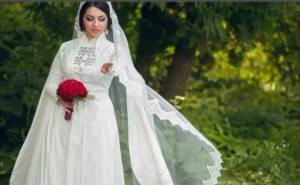
Wedding preparations
Once the engagement is concluded, preparations for the wedding begin.
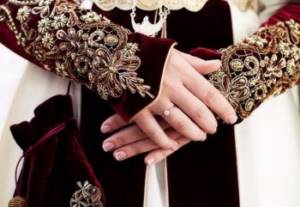
But so that the bride’s parents did not object and stop the preparations, they had to make sure that their daughter would live with dignity. Therefore, relatives get together and go to the groom’s house to check how well his family is. If everything suits them, then preparations continue.
After the visit of the bride's parents, the groom's relatives were supposed to pay a return visit within 2-3 days. At the same time, they brought symbolic gifts, giving gifts to all the girl’s relatives who live with her under the same roof.
This was considered gratitude for being considered worthy.
Wedding day: main traditions and customs
First of all, the bride was dressed and dressed accordingly while on the women's side of the house. Currently, makeup, hairstyle and other preparation elements are done in salons. Where the girl comes accompanied by relatives from the groom's side. All this time, the man does not live at home, but stays with friends, since customs do not provide for meeting with his father and other men of his family before the significant day.
For the first time, the young groom appears at the wedding at the entrance to the registry office.
Therefore, the traditions of the Circassian wedding make the celebration such that all attention is paid to the young bride.
At the agreed time, a delegation from the groom arrives at the bride’s house with gifts and a dowry. It is worth noting that the mother-in-law enjoys special honor. While the men sit down at the table, the ladies open and give gifts to each other. The gifts are unpacked and presented in the presence of older women, after which all those present are treated to sweet wine and sweets.
The man's side must thank the bride's family with a feast with national songs and music. In the modern world, the tradition has changed, and gifts are presented in rented banquet halls, where the previously mentioned delegation of the bride arrives. The entire ceremony is carried out in the absence of the heroes of the occasion.
Next, the ready and dressed bride is taken out into the courtyard. The youth are given 10-15 minutes to see her and dance several dances in the yard. Then she gets into the limousine, accompanied by an accordion player and women from the groom’s side. He himself is driving in another car, because he should not show himself before the registry office.
If there is a car better than a limousine, they choose it for the bride. But average families most often choose a proven option. Then, at quite high speed, the motorcade drives towards the place where the marriage was registered.
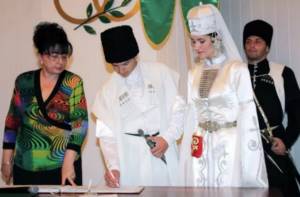
Feast for the whole world
A Karachay wedding is a luxurious, crowded and expensive event. The celebration was carefully organized, a person responsible for maintaining order and customs was appointed, and roles and functions were assigned.
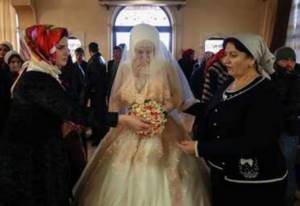
There are usually a lot of guests at a wedding; they come with gifts, giving money, sheep, confectionery, gold. Men and women are seated separately at tables. As a treat, lamb dishes, pies, vegetables, fruits, beer, boza (fermented drink) and other alcoholic drinks are offered.
KNOWLEDGE BASE: Sports style wedding or ring now on your finger!
In the past, the holiday lasted three to seven days, now it is one or two.
The Muslim rite of religious marriage in the past was performed by conspiracy, but nowadays its implementation has shifted closer to the wedding.
Marriage registration procedure
There are no significant differences between a wedding in a registry office and the Russian version. The only significant difference is the absence of the usual kisses of newlyweds. The groom is already present at this stage of the celebration. After registration, at the exit, young people dance a traditional dance in the national style. Then the car ride begins, which can continue until the night.
The newlyweds can go both to the village of the bride’s grandmother and to the village where the young man was born. The couple travels in separate cars. Families, in the absence of the newlyweds, get acquainted and celebrate the celebration in their own circle. if the celebration is celebrated in a banquet hall, then by this time there will be musicians with their own instruments.
At that time, the young people continue to ride, and if the path lies past the bride’s house, he may not stop, but drive at low speed. Thus, giving parents a chance to admire their daughter. At the request of the young people, the cortege can stop by the mosque and listen to the sermons of the effendi.
After the car ride ceremony is completed, the final point is the groom's house. There, the bride's brother may not allow the bride to get out of the car until he receives the ransom. This could be candy, money or alcoholic drinks for older family members. The groom's side can bargain until an agreement is reached. After which the brother leaves in another car along with the entire ransom in an unknown direction.
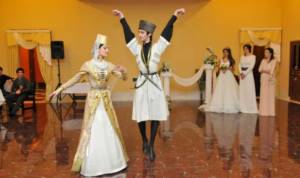
How does matchmaking and engagement work?
As in any tradition, the wedding took place only after matchmaking. But this long action began only after the girl responded to the young man’s signs of attention.
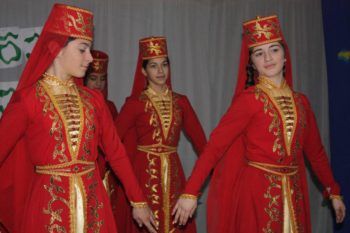
Previously, a special living room was built for a woman who had reached marriageable age, where she could communicate with men in the presence of her younger sister or niece. Now there are more opportunities to get to know each other without tarnishing the girl’s honor.
When a man is ready to get married, he begins to look closely at girls. This is called “soul searching” because in the old days a guy had to travel a lot through villages looking for the right woman. When a man finds a girl who can become his wife, he tries in every possible way to show himself as a good owner and a caring husband.
Romantic actions, gifts, compliments are used - everything to get the girl to agree to marriage.
It is also traditional for his friends to support him, trying to persuade the woman to marry.
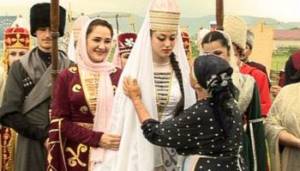
They visit the house of the bride's parents three times, during these visits they are given an affirmative answer and invited to the table. If they are never offered a treat, then this is regarded as a refusal, then the groom can kidnap the bride.
Unlike other eastern cultures, even if a girl is kidnapped and spends the night in a man's house, she can go back to her parents. The public will not judge her.
All the shame will fall on the guy who tried to bondage the woman. Therefore, kidnapping is carried out only if the girl agrees to the wedding.
Feast ceremony: traditions and nuances
After the road is clear for the girl, she is covered with a blanket to the house, preferably a green shade. Next, the girl is blessed by the eldest member of the family on the male side and after that she is escorted to her new home. Next, the eldest woman in the family, who is held in high esteem, ties a symbolic scarf on the young girl’s head.
This ritual shows her acceptance as mother and daughter into the new family. Next, the bride leaves the room with a bow, not being able to turn her back to those gathered - this is a sign of disrespect. The ladies present can help her out.
After observing the basic customs, the newlyweds can go to the feast. It differs from others by the opportunity for each significant guest to speak to the young people. Invited artists join in the congratulations by dancing and singing. It is necessary to have a toastmaster leading the celebration. Today, influenced by European traditions, most weddings feature cake and fireworks.
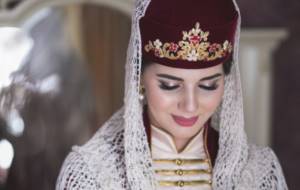
Interesting traditions of the Circassians. Adyghe wedding: ancient customs and rituals
December 21, 2017
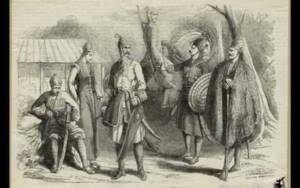
Adygs are one of the indigenous peoples of the North Caucasus . They have been living on the territory of modern Adygea for several millennia, being direct descendants of the ancient population of these places. They are reluctant to leave their homeland: the vast majority of Circassians (a little more than 95 thousand people out of 125 thousand) live in Adygea, and a little more than 20 thousand live in the neighboring Krasnodar Territory. And only a few thousand people moved to Turkey and the Middle East. However, the Circassians remain faithful not only to the land of their ancestors, but also to traditions, the observance of which is one of the requirements for a worthy person.
How society was built among the Circassians
In the old days, the Circassians were divided into many subethnic groups. By the twentieth century, these differences had practically disappeared, and now they speak of a single Adyghe people, sometimes using the synonym “Circassians.” The Circassians themselves call themselves “Adyghe”. One of the largest groups within the Circassians are the Adygeis (along with the Kabardians or Shapsugs).
Despite the commonality of traditions and culture, the Circassian tribes in the old days differed in their method of governance. Some of them managed to introduce the beginnings of democracy and limit the power of the nobility. In these so-called democratic tribes, everything was ruled by elected elders. But in aristocratic tribes, princes led. However, what was common was that the life of the Adyghe tribes was based on a strict class hierarchy. Princes ruled, nobles fought, seizing other people's lands and defending their own, peasants and household slaves worked. Misalliances were not allowed: the prince could not marry a commoner.
A person of each class had to follow the rules prescribed to him. For example, the high-born Circassians practiced atalichestvo: while still children, princely children were sent to the family of a noble person. There they were brought up, became acquainted with their rights and responsibilities (the code of conduct of the Circassians was called “Khabza”). The young prince appeared in his father’s house only after reaching his 16th birthday, and his daughter almost before marriage. Proper upbringing is still valued among the Circassians. A person must be cultured, moral, respectful and brave. For those who do not know how to behave properly, the Adygs still have a saying: “Aren’t you an Adyghe?”
Education of military valor
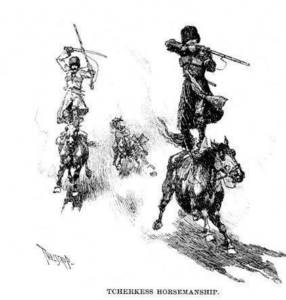
The main character traits of the Circassians, for which they were famous outside their land, were courage and military skill. They were raised as young Circassians from childhood. Over the cradle of a newborn boy, the grandmother sang songs about how brave and dexterous he would be. The grown-up child was put on a horse, taught to throw a knife, handle a dagger, and then shoot with a bow. The Circassians were skilled horsemen and sharp shooters. Anyone who showed cowardice in battle or fear of death was subjected to a humiliating procedure: they put on a dirty hat, put him on a sick horse, and paraded him around like that. Laughing at such a person was not only not prohibited, but also welcomed. The coward became an outcast, an outcast.
Perhaps, it was only with his courage that a real Circassian could attract attention to himself. Modesty was considered a virtue. The Adygs say: a person can only be in the spotlight three times in life - at the moment of birth, on the wedding day and on the day of death. Each of them is accompanied by its own traditions and ceremonies.
Having a baby: everything goes according to the rules
The fact that a child had appeared in the house was signaled by a flag hung on the roof of the house. A motley flag signifies the birth of a girl, while a plain flag indicates the birth of a son. Until the baby is one year old, his paternal grandfather must plant a tree in the yard of his house. The new family member himself will later take care of him. As this tree grows, so does the child gain intelligence and education.
The Circassians prepare everything necessary to care for the baby only after his birth. It is not customary to do this in advance. According to tradition, all bedding is brought by relatives on the mother's side. It is believed that sleeping on linen prepared by the father's relatives is a bad sign (in the future it will bring misfortune to the child in marriage). But the baby’s paternal grandmother puts him in the cradle.
Circassian wedding: the main thing is desire
Surprisingly, it is precisely in the matter of marriage that the Circassians, who are strict about observing traditions, demonstrate respect for freedom and rationality.
The girl is allowed to choose the groom according to her heart. The explanation for this is simple: the family should be strong and happy, divorces are not encouraged. And the best foundation of a strong family is love and mutual respect.
The process of choosing a bride or groom can be quite lengthy. Young boys and girls look at each other at holidays and festivities. Then the girl goes home and receives young people in her room. They get to know each other and talk. At the same time, they have quite a lot of freedom: a guy can visit several girls, and a girl can receive several guys. Having made a choice, the man comes to the woman he likes and proposes. If she agrees, a wedding day is set. True, even on this day she can take back her word - until the guests enter her house. It is not customary to be offended by a refusal, because this is done in a delicate manner, without explaining the reasons.
Like many other Caucasian peoples, the parents of the bride and groom are not present at the wedding. The young people are in different houses, in the company of their friends. The groom's relatives bring a certain symbolic amount to the bride's house - as a sign of respect, and not as a ransom. In turn, her parents transfer a dowry to their daughter’s new home. The bride's relatives are not supposed to stay in the house of the newly-made son-in-law for long, a couple of hours at most.
At the same time, the Adyghe wedding is cheerful and joyful. The bride is showered with sweets, grains and coins, and walks on silk to the house. When entering the house, they take her in their arms so that she does not accidentally step on the threshold under which the souls of their ancestors live. Everyone gives each other gifts. There are other customs - comic ones.
For example, the groom’s grandmother leaves home: they say, the new young mistress will drive me out of my family. The bride, in turn, persuades her to return, gives her sweets and assures that everyone will respect and love her grandmother. The “negotiations” end with hugs and a return home.
In the Adyghe family, a woman occupied a fairly high place. Yes, she obeyed her husband unquestioningly, but she was not allowed to beat or punish her, she was considered the mistress of the house. And although the Circassians have been Muslims since the end of the 18th century, polygamy was not welcomed among them and was rare.
How to see off on your last journey
Funeral rituals also developed quite a long time ago. They are based on Muslim customs. Prayers are read over the deceased and wrapped in white cloth; after the funeral, his clothes are distributed to loved ones. However, these rituals also contain old, pre-Islamic features. For example, in the first three days after the funeral, you cannot cook in the house of the deceased: neighbors and relatives bring food. Mirrors are hung in the house of the deceased, and the women of his family wear black. And although Islam usually prescribes not to cry over the dead, the Circassians do not follow this recommendation. Children are not allowed to attend the funeral: they are taken away from the house in which the accident occurred.
Traditions in modern times
Modern Adygs still honor many ancient customs. It is not customary to eat a lot, talk a lot and express your feelings in public. It is not considered shameful to ask for help from neighbors and relatives, who are obliged to come to the rescue. The traditions of hospitality are also respected: the guest is prepared with the best dishes, given the best place and everything is done to ensure his safety even on the way home.
Second wedding day traditions
On the second day after the celebration, the bride is led into the so-called “big house” or the room of the groom’s parents. The bride covers her face and head with a scarf, and two relatives help her, holding the girl by the arms. At the threshold of the room, the bride should be met by a relative from the groom's side. Lifting the scarf from her face, she smears ghee and honey on the girl's lips. This is a symbol of prosperity and happiness in a new home.
After meeting their daughter-in-law, the ladies sit down at the table. The eldest of those present makes a speech in which she wishes the young family prosperity, happiness and mutual understanding. Interestingly, the bride is obliged to listen to wishes while standing. Despite the fact that she is not seated at the table, after the ritual she can calmly visit the groom’s parents’ room whenever she wants as a family member.
After the wedding celebration is over, the bride's parents are given refreshments as a sign of accepting the girl into the new family. After 3-4 weeks, the young woman goes to visit her parents for a few days. Previously, the interval was 8 weeks from the date of the celebration. At the same time, she brings gifts for all her relatives from her new family.
If you take into account that a Circassian family sometimes represents an entire clan, you can imagine the financial costs. A wedding in Karachay-Cherkessia involves giving gifts in the form of clothes and other items that may be useful to the family on the farm.
Considering the size of the gifts, the bride is assisted on her trip by an additional 20 people. The husband can also accompany the girl, but often the bride is accompanied on her journey by older men of the groom's family.
In the house of the young bride, she meets her son-in-law. Accompanying the introduction of families is the ritual of feasting and refreshments. After this moment, the son-in-law is led into the room where the guests have gathered. After this ritual, he receives the right to visit his wife’s relatives at any time. After returning to her husband, the bride takes away from home not only additional gifts, but also the dowry that her parents have collected for her over the entire period.
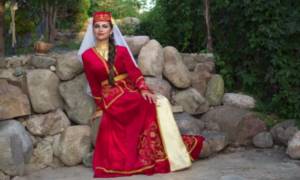
Forms of marriage
In ancient times there were always several different forms of marriage:
- matchmaking marriage. At the first stage, the parties agreed, then the bride price was paid. Only then did the wedding take place. The future newlyweds might not know each other;
- marriage - bride exchange. The stage of collusion, at which the payment of dowry took place, could have been provided even for young children. This was the so-called engagement. In rare cases, such a conspiracy could even be concluded on children who were not yet born. In the event of the death of the groom, for whose marriage the bride price was paid, before the wedding ceremony, the bride's relatives had the opportunity to claim half of the agreed amount;
- marriage is one way or another levirate. Today, this type of marriage is already a relict form. Its meaning was that the widow of one of the brothers becomes the wife of the second. This was explained by the fact that, according to the mountaineers, all the property of the deceased certainly remains in the family, and especially the wife and children;
- Sororate marriage. This form is now outdated. It provides for the marriage of a widower with the sister of his deceased wife.
- secret marriages or with bride kidnapping. Previously, they were very common, but now this custom can only be observed with the consent of the bride. In ancient times, most often, kidnapping was a forced measure, and the reasons could be:
- impossibility of obtaining the consent of the beloved’s parents;
- the bride's refusal to marry;
- insufficient funds to pay the dowry;
- delaying the marriage process.
February wedding
If the kidnapping was successfully completed, the young man was able to obtain the consent of the lady of his heart, as well as her parents, to hold the wedding celebration. The groom's failure was a disgrace for him and his family. For the girl’s relatives, such a step was offensive, and in order to resolve the conflict situation, many people were involved from both sides. They made attempts to reconcile the parents of the groom, as well as the bride. If the kidnapping was successful, the bride price was not paid, and in case of failure, the groom was also required to pay a penalty for reconciliation of the parties, which was called “jarashkhanlyk”.
Features and Circassian wedding
The Circassian celebration has its own nuances. Yes, there is a lot of music and dancing at it, just like at any other celebration. Mostly men take part in the fun. Relatives of the groom's parents are allowed in to join in the fun. Circassian weddings are served by musicians who must be proficient in playing national folk instruments. These include wind, string and plucked versions. However, recently the Russian accordion has also been in use among the Circassians.
The work of the musicians who serve the wedding party is paid for by the inviting family. In addition to the basic payment, they are entitled to additional remuneration for performing folk dances, especially when buying out dancers from the circle of guests. When you consider the fact that a wedding can last up to several days, the extra reward for the amount of work is well worth it.
Dowry
Karachay girls prepare a dowry almost from birth. The dowry must be rich, so it is not customary to skimp on it. If a girl does not have a dowry, they laugh at her and reproach her. The dowry consists of bedding, pillows, carpets, curtains, blankets, tablecloths. Wealthy brides can afford good furniture, expensive household appliances and even a car.
Previously, the best brides were considered to be those who could prepare most of the dowry with their own hands. Today, everything you need is purchased in the store. A Karachay wedding is an expensive event for the bride, because in addition to the dowry, you also need to spend money on gifts for the groom’s relatives. Today, many girls prefer to dress for a wedding in a national costume, which costs much more than a regular classic wedding dress.
The position of the young bride in her husband's family
Despite the magnificent celebration, the life of a young bride in a new family will not seem so cloudless to a Russian person. Because it is surrounded by prohibitions and traditions. For example, she was not allowed to be with her husband in public places, to treat children affectionately and to take them in her arms in the presence of older members of the man’s family, to have a conversation with her father-in-laws and to address them by name was also prohibited. For a Russian woman, a young bride in a Circassian family is like a powerless child.
A woman gained weight in her husband’s family after the birth of her first child, especially a male child. Despite the girl’s lack of rights, she was always treated with respect. Many families adopted knighthood and the protection of women and their honor.
According to local customs, it was not allowed to beat or insult a woman. Rude conversations and mutual insults in the presence of women were unthinkable in Circassian society. In the presence of women, whips were not even used on horses to avoid rudeness. When moving, they were seated in such a way that they did not see the main rude actions towards animals on the part of men.
A Circassian wedding could last up to several weeks and was accompanied by games, dancing and fun. It is worth noting that tables for women and men were set in different rooms. And the young bride was not even given access to the women's table.
During the celebration, food was brought to her room, but she could not see her husband. He himself was usually not at home at such moments; he whiled away the time with friends or distant relatives. The tradition has not outlived its usefulness and is still observed in some Circassian settlements.
Bringing the bride into her husband's parents' house
Upon the bride’s arrival at the groom’s house, various rituals were performed: the boy hugged the bride first, then her grandmother and other women in order of seniority. To make the girl's life prosperous, she was showered with sweets, money and nuts. The honor of taking the bride into the wedding room was given to a woman with many children and the bride's mentor. On the first day of the wedding, the bride and her mentor were in the wedding room, and the groom was in someone else's house. This was part of the tradition of hiding and avoiding relatives.
The ritual of removing scarves, which accompanied the entry of the bride into the house of her husband's parents, has been preserved. The bride’s head and face were covered with several scarves; the girl was taken into a room where the scarves were removed to the song “Oraida”.
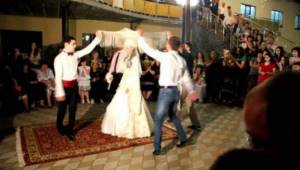
Gifts and dowry were brought into the house. The newlywed was greeted by her husband's mother with pies and her father with buza or honey drink.
